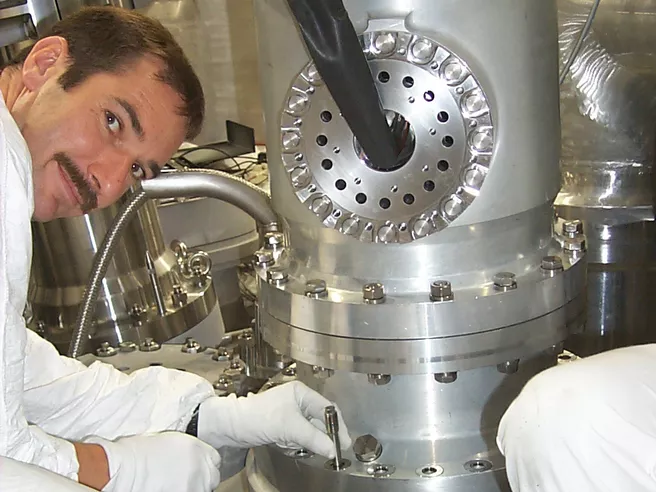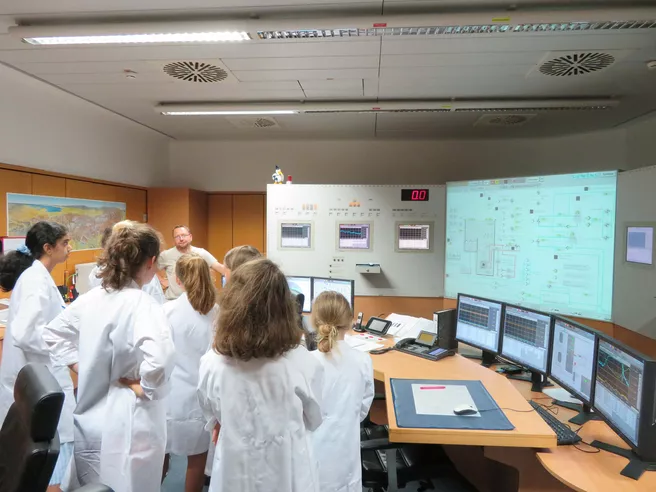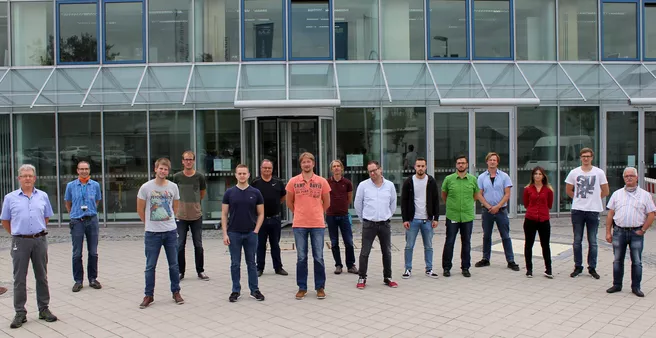With Adolf Lochinger, every move is spot on when he opens the heavy airlock to the reactor hall, the heart of the research reactor. He is the operator group leader of 18 male and one female reactor operators and has been working at FRM II for 29 years. In 1995 he completed his training as a reactor operator, at that time still on the so-called Atom Egg (FRM old) and has been shift manager at FRM II since 2001.
Reactor operator training
The word "reactor operator" might make you think of Homer Simpson (eating his donuts in the control room), but the reactor operators of the FRM II have absolutely nothing in common with the clumsy reactor worker apart from the job title. In order to be able to work in one of the most modern and safest nuclear plants in the world, reactor operators, after completing their vocational training and gaining professional experience in a technical area such as electronics or process engineering, must also go through an additional two-year training course in which they get to know the FRM II in great detail and practice operating all of its systems. "You have to be very fond of technology and look for new challenges every day," says Lochinger about the apprenticeship. In order to keep their extensive specialist knowledge up to date, all employees take part in a mandatory annual training course on technical and safety-related topics.
Control room: workplace of the reactor operators
The workplace of the reactor operators, also known as the control room, is located in the basement of the reactor building and is in the immediate vicinity of their place of work. The control room is the control center of the reactor, from where it is operated. The tasks of the reactor operator include safe operation of the reactor, for example controlling the control rod. Furthermore, the monitoring and maintenance of various systems in the plant, such as cooling circuits, but also devices and special tools for work in the reactor pool. The reactor operators monitor the entire system and thus ensure safety for people, the environment and nature. Although everyone on the team is very familiar with the various systems, each member has a specific role. Most of the members have their specialty, i.e. a system that they know particularly well and look after intensively. It is important to exchange experiences and knowledge at every shift change, so they form a perfectly coordinated team. There is a highly professional and at the same time friendly working atmosphere among the approximately 120 employees at the reactor divison of the FRM II.
In three-shift operation for 20 years
Not only the training requirements, but also the number of staff are specified in official regulations. For the FRM II, this means that the control room must always be manned by at least two (plant standstill) or three people (power operation). To ensure this, the reactor operators have been working in what is known as three-shift operation since 2003. A regular shift lasts a total of eight days. Normally, it starts with a day shift in which the employee can update himself or herself on the upcoming tasks. Then there are two early shifts, two late shifts and finally two night shifts. This is followed by a few days off. Working days also include holidays and weekends.
A total of six full shifts and two additional shift supervisors are needed to reliably meet all the requirements 24/7.
Loyalty to the plant
The shift supervisor on duty has unrestricted powers at the research reactor in the absence of the plant manager and therefore enjoys a very special degree of trust. As shift manager, Lochinger approves all work related to the operation of the FRM II in the broadest sense, which is essential for the facility's own staff, but also, for example, permits external companies to carry out work. The shift manager has the last saying and decides whether the work is compatible with the current safety requirements. Lochinger and his team also check that every knob and valve in the system is set correctly. "The shift supervisor is the last bastion of safety," says Lochinger.
Reactor operator, an extraordinary job
Thanks to years of experience, Lochinger and his colleagues know the reactor inside out. And despite all the routine, the fascination with the work remains. “I still remember when we set everything up here. Standing in the huge empty reactor basin and installing the equipment, moments like this are something you never forget,” says Lochinger. "We are working to ensure that young people continue to discover this fascinating profession here at the neutron source (FRM II) for themselves."


